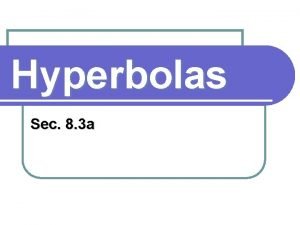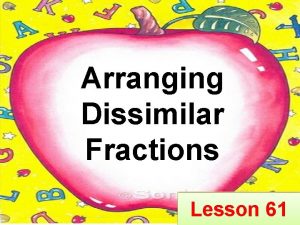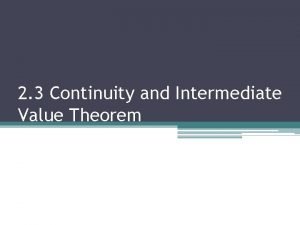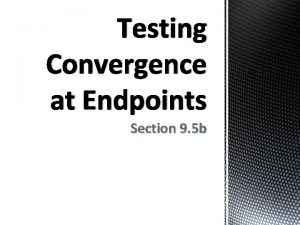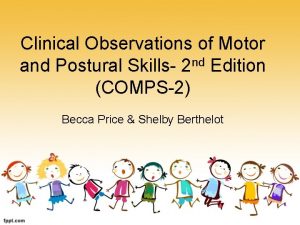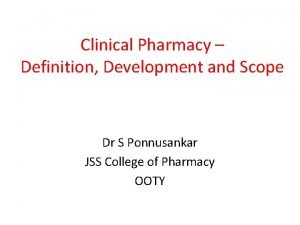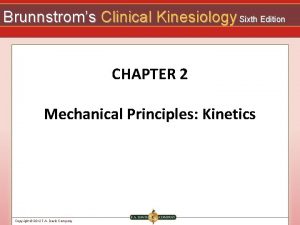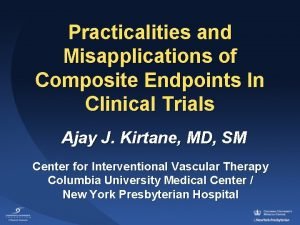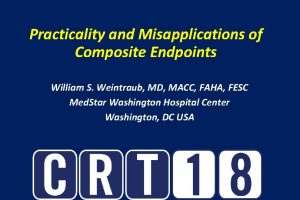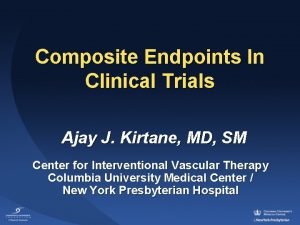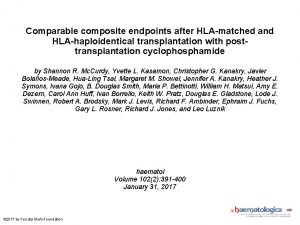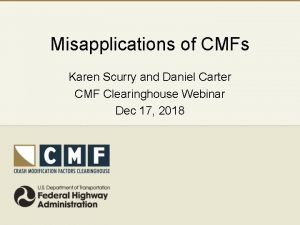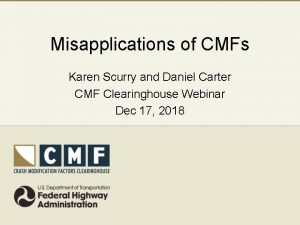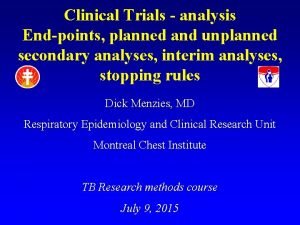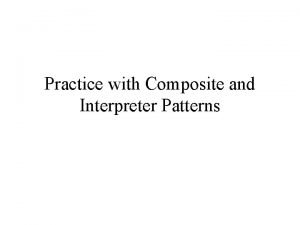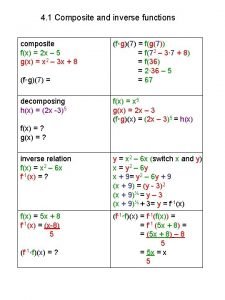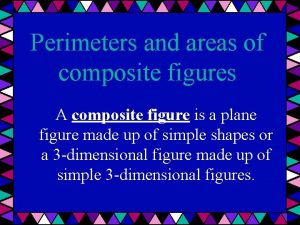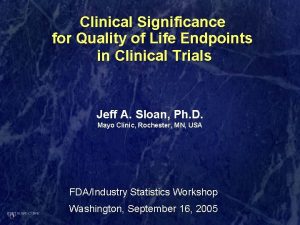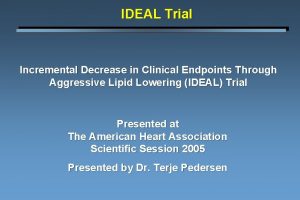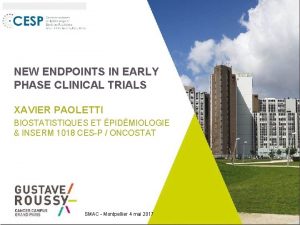Practicalities and Misapplications of Composite Endpoints In Clinical






















- Slides: 22

Practicalities and Misapplications of Composite Endpoints In Clinical Trials Ajay J. Kirtane, MD, SM Center for Interventional Vascular Therapy Columbia University Medical Center / New York Presbyterian Hospital

Ajay J. Kirtane, MD I/we have no real or apparent conflicts of interest to report. Off-Label: Data-driven

What is a Composite Endpoint? • Endpoint that combines several outcomes ¡ Sub-components • Components are typically directionally related (e. g. death/MI) ¡ But may not be “equal” in severity and definitions can vary across trials • May be related to the final outcome (death) but mechanisms can be different ¡ Death/MI/bleeding ¡ Death/MI/TVR

Composite Endpoints • We need them • Individual outcomes can lack power • But this can be abused • We sometimes dislike them • Components vary in their clinical importance • Treatment effect varies across components • May actually lose power by using a composite endpoint!!!

Composite Outcomes in Published CV Trials • 304 trials in 14 journals in 2000 -2006 • 73% had composite as primary endpoint, with a median of 3 components death 98% myocardial infarction 92% reintervention 54% stroke 32% angina 10% hospitalization 12% cardiac failure 9% Lim et al Ann Int Med 2008

Composite Endpoints: Take Care RITA 3 Trial Intervention vs Conservative Patients 895 915 Deaths 26 23 After 4 months MIs 30 34 Refractory angina 39 85 86 (9. 6%) 133 (14. 5%) Death, MI or refractory angina (primary endpoint) Overall p=0. 001 (For Refractory Angina, p=0. 00003) Fox K et al. Lancet 2002; 360(9335): 743 -51

SYNTAX: PCI vs. CABG The Headline at 1 Year: “SYNTAX fails to show non-inferiority for DES” 1800 patients with left main/3 vessel disease Primary Endpoint of MACCE: Composite of death, stroke, MI repeat revascularisation 8

MACCE to 12 Months Cumulative Event Rate (%) CABG (N=897) 20 TAXUS (N=903) P=0. 0015* 17. 8% 12. 1% 10 0 0 6 Months Since Allocation Event Rate ± 1. 5 SE. * Fisher’s Exact Test 12 ITT population

Repeat Revascularization to 12 Months Cumulative Event Rate (%) CABG (N=897) TAXUS (N=903) P<0. 0001* 20 13. 7% 10 5. 9% 0 0 6 Months Since Allocation Event Rate ± 1. 5 SE. * Fisher’s Exact Test 12 ITT population

All-Cause Death/CVA/MI to 12 Months Cumulative Event Rate (%) CABG (N=897) 20 TAXUS (N=903) P=0. 98* 10 7. 7% 7. 6% 0 0 6 12 Months Since Allocation ITT population Event Rate ± 1. 5 SE. * Fisher’s Exact Test

CVA to 12 Months CABG (N=897) Cumulative Event Rate (%) 20 TAXUS (N=903) P=0. 003* 10 0 2. 2% 0. 6% 0 6 12 Months Since Allocation ITT population Event Rate ± 1. 5 SE. * Fisher’s Exact Test

Myocardial Infarction to 12 Months Cumulative Event Rate (%) CABG (N=897) 20 TAXUS (N=903) P=0. 11* 10 4. 8% 3. 2% 0 0 6 12 Months Since Allocation ITT population Event Rate ± 1. 5 SE. * Fisher’s Exact Test

All-Cause Death to 12 Months Cumulative Event Rate (%) CABG (N=897) 20 TAXUS (N=903) P=0. 37* 10 4. 3% 3. 5% 0 0 6 Months Since Allocation 12 ITT population Event Rate ± 1. 5 SE. * Fisher’s Exact Test

SYNTAX Summary at 1 year • Composite MACCE (death/MI/stroke/revasc) driven by repeat revascularization alone • Death/MI/Stroke rates virtually identical • Composite death/MI/stroke had offsetting components • MI with PCI, stroke with CABG • What about other differences not captured in the composite? • What about late outcomes?

2 Primary Stent Endpoints (at 12 Months) 1) Ischemia-driven TLR* and 2) Composite Safety MACE = All cause death, reinfarction, stent thrombosis (ARC definite or probable)**, or stroke Major Secondary Endpoint (at 13 Months) Binary angiographic restenosis * Related to randomized stent lesions (whether study or non study stents were implanted); ** In randomized stent lesions with ≥ 1 stent implanted (whether study or non study stents)

Primary Efficacy Endpoint: Ischemic TLR 10 9 Ischemic TLR (%) TAXUS DES (n=2257) EXPRESS BMS (n=749) Diff [95%CI] = -3. 0% [-5. 1, -0. 9] 8 7 HR [95%CI] = 0. 59 [0. 43, 0. 83] 6 P=0. 002 7. 5% 5 4. 5% 4 3 2 1 0 0 Number at risk TAXUS DES 2257 EXPRESS BMS 749 1 2 3 4 5 6 7 8 9 10 11 12 Time in Months 2132 697 2098 675 2069 658 1868 603

Primary Safety Endpoint: Safety MACE* 10 TAXUS DES (n=2257) EXPRESS BMS (n=749) Safety MACE (%) 9 8. 1% 8. 0% 8 7 6 Diff [95%CI] = 0. 1% [-2. 1, 2. 4] 5 HR [95%CI] = 1. 02 [0. 76, 1. 36] 4 3 PNI=0. 01 PSup=0. 92 2 1 0 0 Number at risk TAXUS DES EXPRESS BMS 1 2 3 4 5 6 7 8 9 10 11 12 Time in Months 2257 749 2115 697 2086 683 * Safety MACE = death, reinfarction, stroke, or stent thrombosis 2057 672 1856 619

PARTNER Endpoints • PRIMARY: All-cause mortality over the duration of the study ¡ Superiority test (two-sided), 85% power to detect a difference, α = 0. 05, sample size = 350 total patients • CO-PRIMARY: Hierarchical composite of all-cause mortality and repeat hospitalization ¡ Non-parametric method described by Finkelstein and Schoenfeld (multiple pair-wise comparisons) ¡ > 95% power to detect a difference, α = 0. 05

Mortality or Repeat Hosp All-cause mortality or Repeat Hospitalization (%) 100 Standard Rx TAVI HR [95% CI] = 0. 46 [0. 35, 0. 59] P (log rank) < 0. 0001 80 60 40 20 0 0 6 12 18 24 Months Numbers at Risk TAVI 179 Standard Rx 179 117 121 102 49 56 23 22 4

PARTNER: Win Ratio Analysis Compare every TAVI pt with Standard pt: Total no. of pairs: 179 x 179 = 32041 Death w TAVI 1 st Death w standard 1 st Hosp survivor w TAVI 1 st Hosp survivor w standard 1 st None of the above 8498 14466 1345 3979 3753 LOSE WIN TIE Win Ratio = Pairs with TAVI win / Pairs with TAVI loss Win ratio for composite: 1. 87 (95% CI 1. 35 -2. 54) Pocock et al Eur Heart J 2011

Weighting Components of Composites • Endpoint Weights ¡ Can discount less important outcomes (e. g. a TLR is worth some fraction of a non-fatal NQWMI) • But from whose perspective? • Outside of QOL / Cost-Effectiveness analyses, there is poor guidance on how to weigh endpoints • Issues of interpretability

Summary: Composite Endpoints • Advantages ¡ May provide gain in statistical power ¡ Simple summary of several outcomes • Disadvantages ¡ Can be clinically difficult to interpret ¡ Combined outcomes of varying importance • Often no clear way to “weigh” these outcomes ¡ What if components go in opposite directions?
 Douglas fir elastic modulus
Douglas fir elastic modulus Physical devices of a computer
Physical devices of a computer It is a line segment whose endpoints lie on the circle
It is a line segment whose endpoints lie on the circle Synerzip
Synerzip A point halfway between two endpoints
A point halfway between two endpoints Endpoints of conjugate axis
Endpoints of conjugate axis Endpoints of conjugate axis
Endpoints of conjugate axis Two collinear rays that do not intersect
Two collinear rays that do not intersect Find the coordinate of the missing endpoint
Find the coordinate of the missing endpoint Change 3 2/7 to improper fraction
Change 3 2/7 to improper fraction Intermediate value theorem
Intermediate value theorem Testing endpoints for convergence
Testing endpoints for convergence The shortest arc connecting two endpoints on a circle
The shortest arc connecting two endpoints on a circle Parallel perpendicular and intersecting lines song
Parallel perpendicular and intersecting lines song Study endpoints
Study endpoints Understanding and managing clinical risk
Understanding and managing clinical risk Clinical observation of motor and postural skills
Clinical observation of motor and postural skills Administrative information systems definition
Administrative information systems definition Clinical and systems transformation
Clinical and systems transformation Nature and scope of clinical psychology
Nature and scope of clinical psychology Community pharmacy definition and scope
Community pharmacy definition and scope Phs human subjects and clinical trials information
Phs human subjects and clinical trials information Brunnstrom's clinical kinesiology 7th edition
Brunnstrom's clinical kinesiology 7th edition





